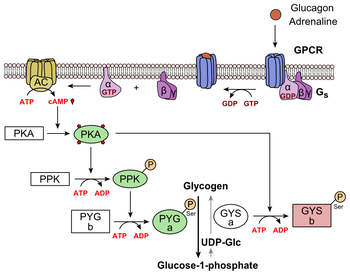Glucagon (medication)
amino terminus below | |
| Clinical data | |
|---|---|
| Trade names | Glucagen, Baqsimi, Gvoke, others |
| AHFS/Drugs.com | Monograph |
| MedlinePlus | a682480 |
| License data | |
| Pregnancy category |
|
subcutaneous injection | |
| ATC code | |
| Legal status | |
| Legal status | |
| Identifiers | |
| |
JSmol) | |
| |
| |
| | |
Glucagon, sold under the brand name Baqsimi among others, is a
Common side effects include vomiting.
Glucagon was approved for medical use in the United States in 1960.[10] It is on the World Health Organization's List of Essential Medicines.[13] It is a manufactured form of the glucagon hormone.[10] A generic version became available in the United States in December 2020.[14]
Medical uses
Low blood sugar
An injectable form of glucagon may be part of first aid in cases of
Beta blocker overdose
Anecdotal evidence suggests a benefit of higher doses of glucagon in the treatment of overdose with
Anaphylaxis
Some people who have
Impacted food bolus
Glucagon relaxes the
Endoscopic retrograde cholangiopancreatography
Glucagon's effect of increasing cAMP causes relaxation of splanchnic smooth muscle, allowing
Adverse effects
Glucagon acts very quickly; common side-effects include headache and nausea.
Drug interactions: Glucagon interacts only with oral anticoagulants, increasing the tendency to bleed.[23]
Contraindications
While glucagon can be used clinically to treat various forms of hypoglycemia, it is contraindicated in patients with
Mechanism of action
This section needs additional citations for verification. (February 2021) |

Glucagon binds to the
Adenylate cyclase manufactures
Additionally, the coordinated control of glycolysis and gluconeogenesis in the liver is adjusted by the phosphorylation state of the enzymes that catalyze the formation of a potent activator of glycolysis called fructose-2,6-bisphosphate.[25] The enzyme protein kinase A that was stimulated by the cascade initiated by glucagon will also phosphorylate a single serine residue of the bifunctional polypeptide chain containing both the enzymes fructose-2,6-bisphosphatase and phosphofructokinase-2. This covalent phosphorylation initiated by glucagon activates the former and inhibits the latter. This regulates the reaction catalyzing fructose-2,6-bisphosphate (a potent activator of phosphofructokinase-1, the enzyme that is the primary regulatory step of glycolysis)[26] by slowing the rate of its formation, thereby inhibiting the flux of the glycolysis pathway and allowing gluconeogenesis to predominate. This process is reversible in the absence of glucagon (and thus, the presence of insulin).
Glucagon stimulation of PKA also inactivates the glycolytic enzyme pyruvate kinase.[27]
History
In the 1920s, Kimball and Murlin studied pancreatic extracts, and found an additional substance with hyperglycemic properties. They described glucagon in 1923.[28] The amino acid sequence of glucagon was described in the late 1950s.[29] A more complete understanding of its role in physiology and disease was not established until the 1970s, when a specific radioimmunoassay was developed.
A nasal version was approved for use in the United States and Canada in 2019.[11][30][31][32][33]
On 10 December 2020, the Committee for Medicinal Products for Human Use (CHMP) of the European Medicines Agency (EMA) adopted a positive opinion, recommending the granting of a marketing authorization for the medicinal product Ogluo, intended for the treatment of severe hypoglycemia in diabetes mellitus.[34] The applicant for this medicinal product is Xeris Pharmaceuticals Ireland Limited. It was approved for medical use in the European Union in February 2021.[7]
References
- ^ "Glucagon Use During Pregnancy". Drugs.com. 16 October 2019. Retrieved 16 May 2020.
- ^ "Baqsimi Product information". Health Canada. Retrieved 30 March 2024.
- ^ "GlucaGen Hypokit 1 mg - Summary of Product Characteristics (SmPC)". (emc). 15 June 2015. Retrieved 16 May 2020.
- ^ a b c "Glucagon kit". DailyMed. Retrieved 27 February 2021.
- ^ "Baqsimi- glucagon powder". DailyMed. Retrieved 27 February 2021.
- ^ "Baqsimi EPAR". European Medicines Agency. 17 October 2019. Retrieved 27 February 2021.
- ^ a b "Ogluo EPAR". European Medicines Agency (EMA). 9 December 2020. Retrieved 27 February 2021.
- ^ "Ogluo Product information". Union Register of medicinal products. Retrieved 3 March 2023.
- ^ ISBN 9780857111562.
- ^ a b c d e f g h "Glucagon". The American Society of Health-System Pharmacists. Archived from the original on 26 December 2016. Retrieved 8 December 2016.
- ^ a b "FDA approves first treatment for severe hypoglycemia that can be administered without an injection". U.S. Food and Drug Administration (FDA) (Press release). 24 July 2019. Retrieved 16 May 2020.
- ^ "Glucagon (GlucaGen) Use During Pregnancy". www.drugs.com. Archived from the original on 27 December 2016. Retrieved 27 December 2016.
- hdl:10665/325771. WHO/MVP/EMP/IAU/2019.06. License: CC BY-NC-SA 3.0 IGO.
- ^ "FDA Approves First Generic of Drug Used to Treat Severe Hypoglycemia". U.S. Food and Drug Administration (FDA) (Press release). 28 December 2020. Retrieved 28 December 2020.
- S2CID 34512730.
- PMID 14567487.
- PMID 18925301.
- PMID 19272219.
- PMID 21929913.
- ^ PMID 22441787.
- (PDF) from the original on 8 August 2013.
- PMID 23266207.
- PMID 5415418.
- ^ PMID 25905350. Retrieved 6 April 2022.
- PMID 2822019.
- PMID 6327193.
- PMID 183209.
- from the original on 29 September 2007.
- .
- ^ "Drug Approval Package: Baqsimi". U.S. Food and Drug Administration (FDA). 25 November 2019. Retrieved 17 May 2020.
- ^ "Ready for rescue: new nasally administered glucagon for severe hypoglycemia approved in Canada!". Diabetes Canada. 12 December 2019. Retrieved 16 May 2020.
- ^ "GLUCAGON NASAL POWDER (BAQSIMI — ELI LILLY CANADA INC)" (PDF). CADTH. 22 January 2020. Retrieved 16 May 2020.
- ^ "glucagon". CADTH.ca. 25 June 2019. Retrieved 17 May 2020.
- ^ "Ogluo: Pending EC decision". European Medicines Agency (EMA). 10 December 2020. Archived from the original on 1 January 2021. Retrieved 11 December 2020. Text was copied from this source which is © European Medicines Agency. Reproduction is authorized provided the source is acknowledged.
External links
- "Glucagon Nasal Powder". MedlinePlus.
